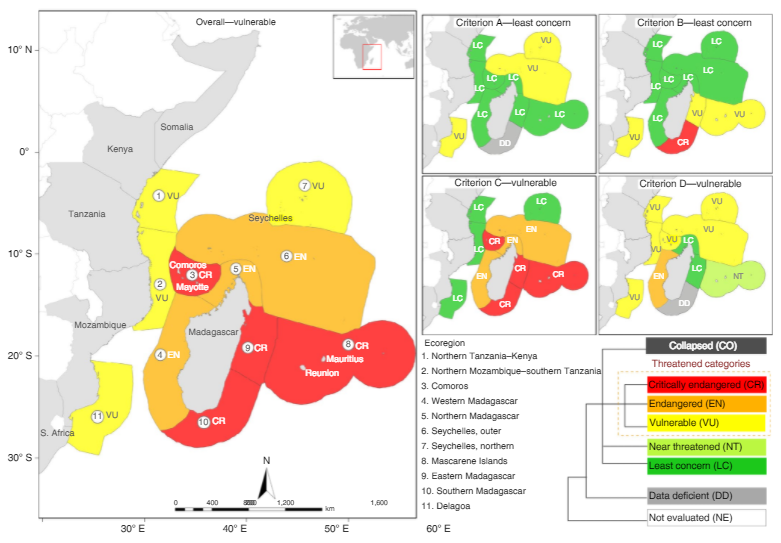A German analysis finds that the threatening scenarios about the imminent death of all coral reefs in a recent study cannot be justified.
====================================================
The corals off East Africa, doomed to extinction?
By Frank Bosse
(Translated, edited by P. Gosselin)
An agency report startles readers: “All coral reefs in the western Indian Ocean are in danger of dying“. The report refers to this study, which highlights a whole series of risks, such as overfishing in the coming years, which threatens the coral reefs.
How fishing will develop in the next 50 years, however, is still up in the air. Of particular interest is the climatic context, which is also brought to the fore in the reports, as climate models can be used here.
If the water gets too warm, then coral bleaching results.”
In fact, such coral bleaching has been observed again and again, and occurs more frequently at water temperatures above 30°C. This happens now and then locally in the Pacific, especially during El Niño events. So now the total collapse is predicted in 2070.
We took a closer look at the study, focusing on the projected climate stress. The study area is described in Fig. 1 of the study, along with the threats from various factors:

Fig. 1, A reproduction of Fig.1 of the study. Criterion C is what is directly related to climate. However, this determines the particularly vulnerable (red) areas in the final result (left), it is the decisive criterion for the particularly critical spaces.
In the study, an emissions scenario is assumed, it is the one with the second strongest emissions. It provides an additional anthropogenic radiative forcing of 6W/m² by 2100, it is called “RCP 6.0” according to IPCC AR5. RCP 8.5 provides the highest warming, it was deliberately not used in the study, with reference to works that classify it as unrealistic.
Now RCP 6.0 is used. We asked ourselves whether this assumed forcing over the last 40 years corresponds with the observations. The first thing to note is that there are coral reefs at some water depth (up to 60 meters). So the first question is whether the temperatures at the surface are at all representative of these water depths. For this purpose we used the observations of the “Argo” system in the study area (Fig. 1), which also evaluates measurements at water depth.

Fig. 2: Water temperatures down to a depth of 100m between 2004 and 2020 in the observation area. Source: Argo.
We see: Up to about 60 meters, the highest water temperatures of around 28°C occur between February and April (summer in the southern hemisphere) every year. In this respect and in these months, the sea surface temperatures (SST) are therefore representative.
Models overestimate
How well does the mean of the models used (CMIP5) represent the observations of SST?
For a comparison, we restricted ourselves to the months with the highest SST, as they are the decisive ones for the coral bleaching mentioned. We compared the MMM (Multi Model Mean), driven by the RCP 6.0 used in the study, with the observations according to ERSSTv5.

Fig. 3: The observed SST (blue) and the modelled SST (red) with their respective linear trends between 1980 and 2020. Note the peaks in the 1997, 2010 and 2016 El Nino events.
The linear increase of the model mean is 30% higher than the observed one.
The RCP 6.0 scenario used overestimates the observed warming of the last 40 years by 30%.
So the question is: Is a claim on upcoming coral bleaching from climate model observations robust?
In Fig. 1, the particularly endangered areas are also spatially described in great detail. What do models do in this area? We looked at this and compared the spatially resolved correlation of the model mean with the observations:

Fig. 4: The spatial correlation between real observations and the model mean in the evaluation period. In large parts it only reached values below 0.5, which is not a satisfactory result. Chart generated with KNMI Climate Explorer.
The question of whether the models used are really suitable for depicting the conditions off the African east coast around Madagascar must therefore be sent back to the study’s authors.
We conclude: rather not.
The conclusions of the study must therefore be classified as “overconfident” after a critical examination.
The models neither correctly represent the observed warming rate (30% too high), nor its spatial expression. Models with their high uncertainties simply cannot do that. The paper must therefore be classified as descriptive of one of many possibilities.
The headline of the agency report once again conveys threatening scenarios about the imminent death of “all coral reefs”, which cannot be justified or supported.





” The paper must therefore be classified as descriptive of one of many possibilities. ”
RCP 6 assumes more than a doubling of ppm of CO2 to 850 by 2100.
At current increases, this is too high. 625 is a better guess.
“One of Many” is a concept more folks ought to keep in mind when the models producing scenarios are used. (See Monte Carlo simulation)
[…] From the NoTricksZone […]
[…] From the NoTricksZone […]
[…] From the NoTricksZone […]
[…] From the NoTricksZone […]